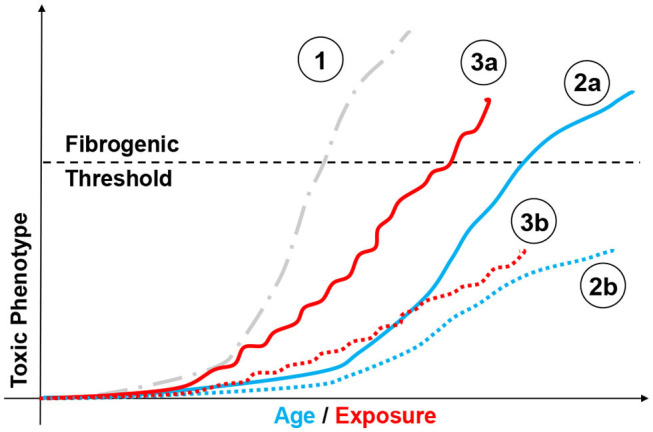Figure 3.

Modeling chemical exposure on the fibrotic phenotype. Depiction of possible outcomes resulting from aging and chemical exposure and their relationship to fibrogenesis. Highly fibrogenic chemical exposure (1, gray dotted line,  ) may drive rapid and possibly lethal fibrosis after a single exposure. By comparison, aging may lead to different disease profiles based on factor such as genetic instability (i.e., SP-C mutation). In such case, an individual presenting somatic mutations may be predisposed to develop a fibrotic phenotype without toxic challenge (2a, blue line,
) may drive rapid and possibly lethal fibrosis after a single exposure. By comparison, aging may lead to different disease profiles based on factor such as genetic instability (i.e., SP-C mutation). In such case, an individual presenting somatic mutations may be predisposed to develop a fibrotic phenotype without toxic challenge (2a, blue line,  ), compared to a healthy individual (2b, blue dotted line,
), compared to a healthy individual (2b, blue dotted line,  ). Similar responses can be observed following mild/moderate repeated exposure, with susceptible population (3a, red line,
). Similar responses can be observed following mild/moderate repeated exposure, with susceptible population (3a, red line,  ) passing the “fibrogenic threshold", whereas healthy cohorts will not. (3b, red dotted line,
) passing the “fibrogenic threshold", whereas healthy cohorts will not. (3b, red dotted line,  ) or never reach that threshold depending on factor such as genetic susceptibility. Similarly, aging may be associated with fibrotic and non-fibrotic outcomes depending on individual biological clocks.
) or never reach that threshold depending on factor such as genetic susceptibility. Similarly, aging may be associated with fibrotic and non-fibrotic outcomes depending on individual biological clocks.
